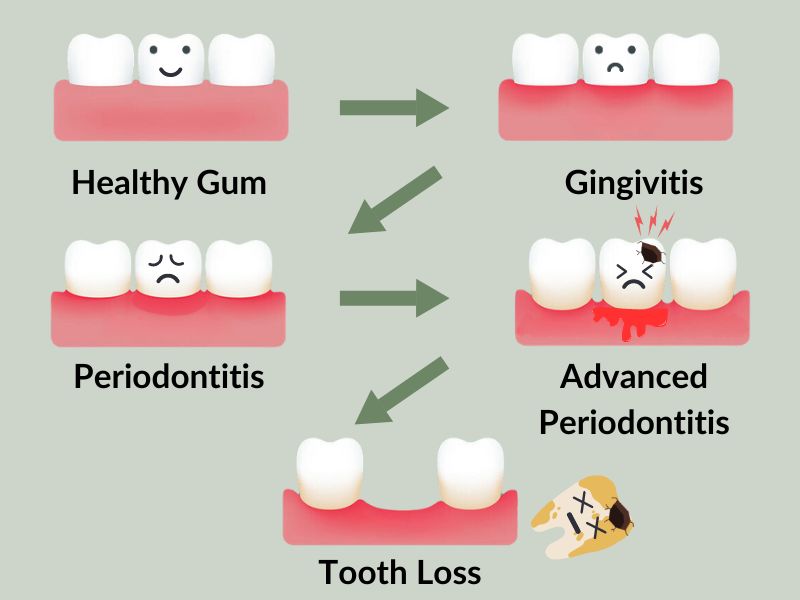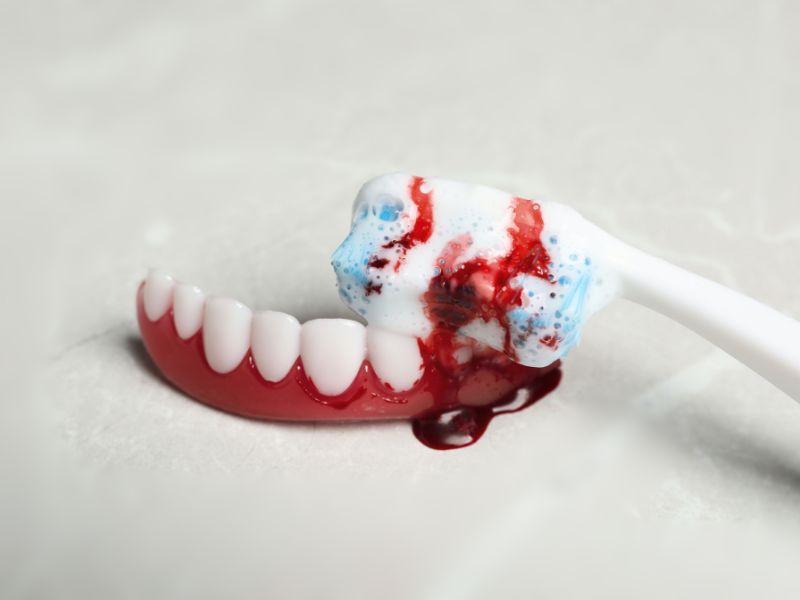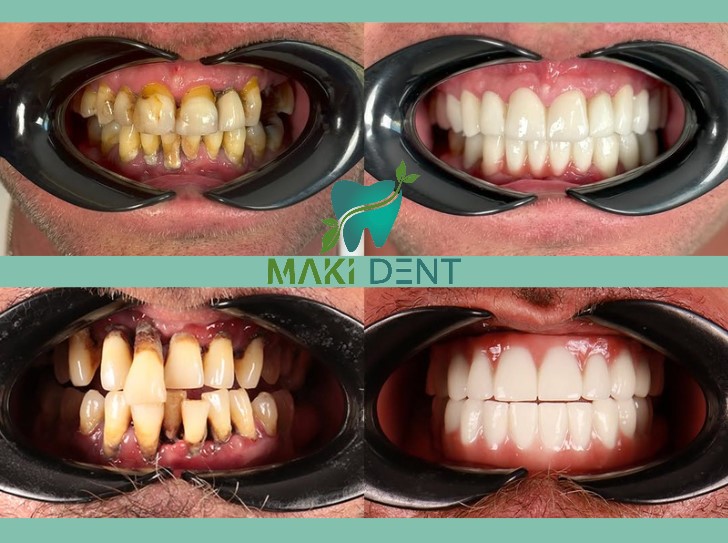
If you have seen blood on your toothbrush or redness and blisters on your gums while brushing your teeth, but you have not taken it seriously, thinking that it will pass over time, we advise you to think again. Because your gums have started to send you a signal, and if left untreated, your gums will move away from your teeth and cause tooth loss. Gum recession is very common in society, and according to research, almost 30% of the population suffers from this condition.
So, how far can the gums recede before the teeth fall out? In other words, how long will your tooth or teeth fall out if you have a gum recession problem and if left untreated? You may be wondering the answer to this question. However, to avoid facing this lousy end, we recommend contacting Makident without wasting any time and getting examined and treated by one of our dentists, who are experts in all kinds of dental and oral health issues, including gum recession
As Maki Dent Clinic, we offer dental services you can trust with our modern and state-of-the-art equipped clinic, including preventive care and cosmetic dentistry, along with our expert dentists and staff in their fields.
What is Gum Tissue?
Gum tissue, medically known as the gingiva, is the pink-coloured soft tissue that surrounds and protects the teeth. It encases the neck of the teeth and shields the roots from external factors. The gum tissue is firmly attached to the jawbone and is rich in blood vessels, contributing to the health of the teeth and surrounding tissues.
Healthy gums help keep the teeth stable and protect the tooth roots from infections. Conditions such as gum recession can cause the gum tissue to recede and expose the tooth roots, leading to detrimental effects on dental health.
What is Gum Recession?
Gum recession occurs when the gums pull back from the teeth, exposing the roots. This process typically progresses slowly, making it difficult to notice in the early stages. Gum recession leads to a reduction in gum tissue and the formation of "pockets" between the teeth and gums. These pockets create an ideal environment for bacteria to accumulate, which can endanger the health of both teeth and gums.
If left untreated, gum recession can lead to serious gum and bone problems, potentially resulting in tooth loss. Gum recession can have various causes, and appropriate treatment is determined based on the underlying factors. Therefore, it is essential for individuals suspecting gum recession to consult a dentist.
What are the Symptoms of Gum Recession?
The symptoms of gum recession usually manifest through noticeable changes in the teeth and gums. These symptoms may include:
- Tooth Sensitivity: One of the early signs of gum recession is increased sensitivity in the teeth. Discomfort or pain may occur when exposed to hot, cold, sweet, or acidic foods and beverages.
- Bleeding While Brushing or Spontaneously: Bleeding in the gums, especially during brushing or even during normal activities, can be a sign of gum recession.
- Bleeding While Eating Hard Foods: The gums may bleed while eating hard foods such as apples or pears.
- Teeth Appearing Longer Than Usual: As the gums recede, the teeth may appear longer than usual due to the exposure of the roots.
- Redness or Swelling in the Gums: Redness, swelling, or inflammation in the gums can also be an indication of gum recession.
If you notice one or more of these symptoms, it is important to consult a dentist to assess the potential for gum recession.

What are the Stages of Gum Disease?
Gum disease is a condition that negatively affects oral health and can lead to serious problems if left untreated. This disease is mainly divided into two main stages: gingivitis and periodontitis. As a result of the progression of untreated gingivitis periodontitis is divided into four stages. These stages are classified according to the severity, complexity and prevalence of the disease.
Gingivitis The First Stage of Gum Disease
Periodontitis is usually preceded by a gingivitis called 'gingivitis'. Gingivitis is inflammation of the gums due to the accumulation of bacterial plaque. Symptoms include redness and swelling of the gums and bleeding when brushing. Since there is no bone or tooth loss at this stage, gingivitis is reversible. Gingivitis can be easily treated with proper oral hygiene and regular dental check-ups. Without early intervention, gingivitis can develop into periodontitis and lead to more serious problems.
Stages of Periodontitis
Periodontitis is analysed in four stages according to the severity, complexity and prevalence of the disease:
Stage 1: Initial Stage
- Severity: There is a slight loss of 1-2 mm in the connection between tooth and gum.
- Bone Loss: There is less than 15% destruction of the alveolar bone (the jaw bone that holds the teeth).
- Tooth Loss: No teeth are lost.
- Symptoms: There may be mild redness and bleeding in the gums.
Stage 2: Intermediate Stage
- Severity: Loss of connection reaches 3-4 mm.
- Bone Loss: Bone destruction is between 15-30%.
- Tooth Loss: There is still no tooth loss.
- Symptoms: Increased sensitivity of the gums, bleeding and bad breath may be observed.
Stage 3: Advanced Stage
- Severity: Loss of connection is 5 mm or more.
- Bone Loss: Bone destruction is 50% or more.
- Tooth Loss: At least 4 teeth have been lost.
- Symptoms: Loose teeth, difficulty in chewing and significant bad breath appear.
Stage 4: Very advanced stage
- Severity: Connection loss is again 5 mm or more.
- Bone loss: 50% or more bone destruction continues.
- Tooth Loss: At least 5 teeth have been lost.
- Symptoms: Severe loose teeth, damage to the jawbone and aesthetic problems.
Note: At this stage, missing teeth may need to be rehabilitated with implants or bridges.

Degrees of Periodontitis
The rate of progression of periodontitis determines the grades of the disease and is divided into three main categories. Grade A is slowly progressing periodontitis and is seen in people who have not lost bone or connection in the last 5 years, do not smoke and do not have diabetes. Grade B is the moderately progressive type; at this stage, there is less than 2 mm bone loss in the last 5 years, the patient may smoke less than 10 cigarettes a day, or their diabetes is well controlled. Grade C is rapidly progressive periodontitis; there is bone loss of 2 mm or more in the last 5 years, the patient smokes more than 10 cigarettes a day or his/her diabetes is not under control. As the rate of disease progression increases, the risk factors increase and urgent treatment is needed. (Source)
How Far Can Gums Recede Before Teeth Fall Out?
For reference, healthy periodontal pockets range in size from 1 to 3 millimeters, which is the normal value. However, a pocket of 4 mm indicates periodontitis. A gingival pocket of 5 millimeters or more is a sign of periodontal disease. After this stage, as the disease progresses, the teeth begin to wobble and may even be extracted or fall out.
How Long Does It Take for Gum Disease to Cause Tooth Loss?
The time it takes for gum disease to lead to tooth loss depends on the severity of the disease and the level of oral hygiene maintained by the individual. Gum disease is usually a slow-progressing condition, with its initial stage, gingivitis, characterised by redness, swelling, and bleeding of the gums. This stage is reversible with proper oral care and can be completely treated.
However, if left untreated, gingivitis can progress to a more serious condition known as periodontitis. Periodontitis causes damage to the bone and connective tissue that support the teeth. This damage weakens the support structure of the teeth, causing them to loosen and eventually leading to tooth loss. It may take several years for periodontitis to reach this stage, though factors such as genetic predisposition, lifestyle, and smoking can accelerate the process.
Generally, it may take several years for gum disease to result in tooth loss, but with early detection and regular dental check-ups, this process can be halted and tooth loss can be prevented. Without treatment, loose and falling teeth become inevitable. Therefore, maintaining regular dental visits and proper oral care is crucial for gum health.
What Types of Surgery are Used to Treat Gum Recession?
The treatment for gum recession depends on the severity of the condition and the underlying causes. Below are some common treatment methods for gum recession:
- Deep Cleaning (Root Planing and Scaling): In mild cases of gum recession, the dentist may perform a deep cleaning. During this procedure, plaque and tartar that have accumulated below the gum line are carefully removed. The root surfaces are also smoothed to prevent bacteria from adhering to these areas. This can promote the reattachment of healthy gum tissue to the teeth.
- Antibiotic Therapy: If necessary, the dentist may prescribe antibiotics to eliminate any remaining harmful bacteria after deep cleaning. This helps control infection and improve gum health.
- Gum Surgery: In advanced cases of gum recession, where there is significant bone loss or deep pockets, deep cleaning may not be sufficient. In such cases, gum surgery may be required to repair the gum tissue, reduce pocket depth, and restore gum health.
In advanced cases of gum recession with significant bone loss or deep pockets, deep cleaning may not be sufficient and surgical treatment may be required. Surgical treatment methods include:
- Gum tissue surgery: A surgical procedure to repair gum tissue, reduce pocket depth, and restore gum health.
- Gum graft surgery: This is a long-term type of surgery performed when there is a lack of gum tissue. During this procedure, a gum graft is sutured to complete the missing gum tissue. The graft can usually be taken from the palate or from a sterile human donor.
These treatments aim to repair the damage caused by gum recession and restore gum health. Early intervention plays a vital role in preventing further progression.
Who is at Risk of Gum Recession?
Due to various factors, some people may be more prone to gum recession. Those at higher risk include:
Aging:
The risk of gum recession increases as people get older. It is especially common in people over the age of 65. Studies show that about 88% of people aged 65 and over have experienced gum recession in at least one tooth.
Hormonal Changes
Conditions that affect hormone levels, such as puberty, pregnancy, and menopause, can make the gums more sensitive, and this sensitivity can progress to bleeding gums, which can lead to gum recession.
Genetic Predisposition:
If there is a family history of gum recession, the likelihood of developing the condition increases due to genetic factors. A genetic predisposition can make gum disease more likely to occur.
Tobacco Users:
Smoking and the use of tobacco products negatively affect gum health and increase the risk of gum recession. The damaging effects of tobacco on the gums make smokers more vulnerable to this issue.
Diabetes:
Individuals with diabetes are at risk of gum recession due to a weakened immune system, making them more susceptible to infections.
Poor oral health and dental plaque:
One of the most common causes of gum recession is poor oral hygiene and dental plaque. Dental plaque is a breeding ground for germs. Plaque buildup hardens, forming new pockets in the teeth and accelerating gum recession.
Periodontal Diseases:
Gingivitis and periodontitis
Gingivitis and periodontitis, usually caused by bacterial infections, will progress if left untreated and cause the gum tissue to recede from the teeth.
Aggressive tooth brushing:
The biggest indicator of brushing is that the toothbrush is worn out in less than 3 months. Aggressive tooth brushing will lead to constant irritation of the gums, gingivitis, and bleeding, especially in people with gum sensitivity, and eventually to recession of the gum tissue from the teeth..
Bruxism
The pressure on the teeth due to bruxism can move the gums, triggering tooth movement and gum recession. As a result, worn teeth can come out of their sockets and lead to large gum pockets where bacteria can grow.
Misalignment of the position of the teeth:
Crooked and misaligned teeth can put more pressure on the gums than they should, resulting in gum recession.
Trauma or Injury:
Dental trauma and injury can cause damage to the vessels and nerves of the tooth and to the gums. Left untreated, this damage can lead to tooth loss.
Those with these risk factors should take extra care of their oral health to prevent or manage gum recession at an early stage.
How Can Gum Recession Be Prevented?
Preventing gum recession primarily involves maintaining a proper and effective oral care routine. Here are some tips for preventing gum recession:
- Brush your teeth at least twice a day with a fluoride toothpaste.
- Use dental floss to remove plaque and food debris between your teeth, helping to prevent plaque build-up and protect gum health.
- Visit your dentist at least twice a year for cleanings and early detection of potential issues.
- Ensure your toothbrush has soft bristles to avoid irritation to the gums, which can lead to gum recession.
- Quit smoking and using tobacco products, as they can contribute to gum disease and increase the risk of gum recession.
- Maintain a balanced and healthy diet rich in vitamins and minerals. Vitamin C, in particular, is essential for maintaining healthy gum tissue. (study)
Can gum recession occur after dental implant treatment?
Yes, gum recession after dental implant (all-on-6, all-on-4, single) can occur and can be treated. However, the treatment method may vary depending on the severity, cause and condition of the implant.
At what age do the gums start to recede?
Gingival recession, also known as gingival recession, can occur at any age, including youth. However, it is often seen in adults over 40 years of age. As a result, the likelihood of gum recession increases with age; According to a study conducted in the USA, 38% of people aged 30-39 years have some degree of this condition, while this rate is 71% in the 50-59 age group and 90% in the 80-90 age group.
How long does gum treatment take?
The duration of gum treatment varies according to the progression of the disease. This period can usually vary between 1 month and 1 year.
Can receding gums grow back?
Gingival recession problems are problems that cannot be corrected spontaneously. Unfortunately, gum tissue cannot renew itself like other tissues. If gingival recession is treated early, a great advantage is provided and tooth loss is prevented.
Which vitamin deficiency causes gum recession?
Vitamin types can be effective in protecting gum integrity. Deficient consumption of vitamins A, C, D, K, and B group vitamins can lead to gum problems.
Can gingival recession be treated during pregnancy?
Emergency tooth and gum treatment can be performed with the opinion of the gynaecologist. However, it is recommended to postpone non-urgent tooth and gum treatments until after pregnancy. Since the baby completes its development in the second trimester of pregnancy, dental treatment is more appropriate.
